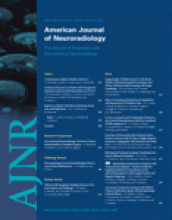Abstract
SUMMARY: Generalized lymphangiomatosis is a rare congenital malformation of the lymphatics, characterized by cystic lesions in parenchymal organs and lytic bone lesions. In this report, we describe the radiographic and clinical features of 2 unusual cases of generalized lymphangiomatosis with bilateral orbital involvement.
Generalized lymphangiomatosis was first described by Rodenber in 1828.1 This rare disease manifests principally in childhood and most commonly presents with cystic lesions in visceral organs and lytic bone lesions. Orbital lymphangioma is a more common entity occurring sporadically in childhood. Simultaneous occurrence of both processes has rarely been described.2 We describe 2 unusual cases of bilateral orbital lymphangiomas in patients with generalized lymphangiomatosis.
Case Reports
A 31-year-old man with known diagnosis of diffuse lymphangiomatosis presented with worsening right proptosis. Fat-suppressed T2-weighted MR imaging demonstrated bilateral hyperintense masses separate from the extraocular muscles. Multiple similar-appearing lesions were also noted in the masticator spaces (Fig 1A). Postcontrast imaging failed to demonstrate enhancement within the lesions; the constellation of findings was consistent with the diagnosis of orbital lymphangiomas (Fig 1B). In addition, multiple areas of abnormal hyperintense signal intensity were noted in the calvaria and upper cervical vertebral bodies on the T2-weighted sequences (Fig 1C).
A 31-year-old man with known generalized lymphangiomatosis presents with right proptosis.
A, Coronal fat-suppressed T2-weighted MR image demonstrates bilateral extramuscular hyperintense lesions. Additional masses with similar signal intensities are noted in the masticator spaces.
B, Low T1 signal intensity in these lesions without contract enhancement.
C, Coronal T2-weighted MR image demonstrates high-signal-intensity lesions in the occipital condyles and upper cervical vertebrae.
A 28-year-old man without known medical history underwent contrast-enhanced CT scanning of the neck and chest for evaluation of an abnormal mediastinal contour noted on a chest radiograph. On the contrast-enhanced CT images of the chest, a nonenhancing fluid-attenuation mass was demonstrated in the mediastinum (Fig 2A). Images through the orbits demonstrated bilateral nonenhancing retrobulbar fluid-attenuation lesions (Fig 2B). Multiple lytic lesions were identified in the cervical spine and skull base (Fig 2C). A subsequent contrast-enhanced CT scan of the abdomen demonstrated multiple intraperitoneal fluid-attenuation lesions (Fig 2D).
A 28-year-old man presents with a mediastinal mass on a chest x-ray for further work-up.
A, Axial contrast-enhanced CT scan of the chest demonstrates multiple nonenhancing cystic lesions in the mediastinum.
B, Axial contrast-enhanced CT scan of the neck at the level of the orbits demonstrates bilateral nonenhancing retrobulbar low-attenuation lesions.
C, Axial contrast-enhanced CT scan of the neck viewed at bone window settings demonstrates multiple lytic lesions of the occiput and upper cervical vertebrae.
D, Axial contrast-enhanced CT scan of the abdomen demonstrates multiple nonenhancing cystic lesions in the peritoneum.
Both patients had numerous soft-tissue and osseous lesions compatible with the clinical diagnosis of diffuse lymphangiomatosis. In addition, each patient had multiple bilateral lobular nonenhancing retrobulbar masses with imaging features typical of orbital lymphangiomas.
Discussion
Lymphangiomas are rare benign lesions that are believed to result from abnormal development of the lymphatic system. Occasionally, lymphangiomas occur diffusely, and this process is referred to as “generalized lymphangiomatosis.” Generalized lymphangiomatosis most commonly presents with cystic lesions in visceral organs, mesenteric thickening, lytic bone lesions, diffuse thickening of the pulmonary interstitium, pulmonary nodules, mediastinal masses, and pleural and pericardial effusions.3 However, due to its widespread distribution, lymphangiomatosis may be seen in virtually any organ that contains lymphatic tissue.
Orbital lymphangioma is a more common benign cystic lesion, generally manifesting in childhood and often presenting with proptosis, exacerbated by intralesional hemorrhage. It can be locally infiltrative and grow along tissue planes, making resection difficult and the outcome dismal, with frequent local recurrence. Wright et al,4 in a series of 158 patients with orbital lymphangiomas, found that the tumor was unilateral in all cases. To our knowledge, only 1 published case report of bilateral orbital lymphangiomas has been presented in the literature. In that case, the patient also had generalized lymphangiomatosis.
In summary, we present 2 cases of bilateral orbital lymphangiomas in patients with generalized lymphangiomatosis. Because generalized lymphangiomatosis is a diffuse disease with widespread distribution, it is expected that lymphangiomas may occur in virtually any organ that contains lymphatic tissue. Our cases suggest that especially in patients with bilateral multiple orbital lymphangiomas, generalized lymphangiomatosis should be strongly considered. Alternatively, in patients with the diagnosis of diffuse lymphangiomatosis, proptosis is likely related to the presence of orbital lymphangiomas.
- Received February 14, 2006.
- Accepted after revision March 1, 2006.
- Copyright © American Society of Neuroradiology














